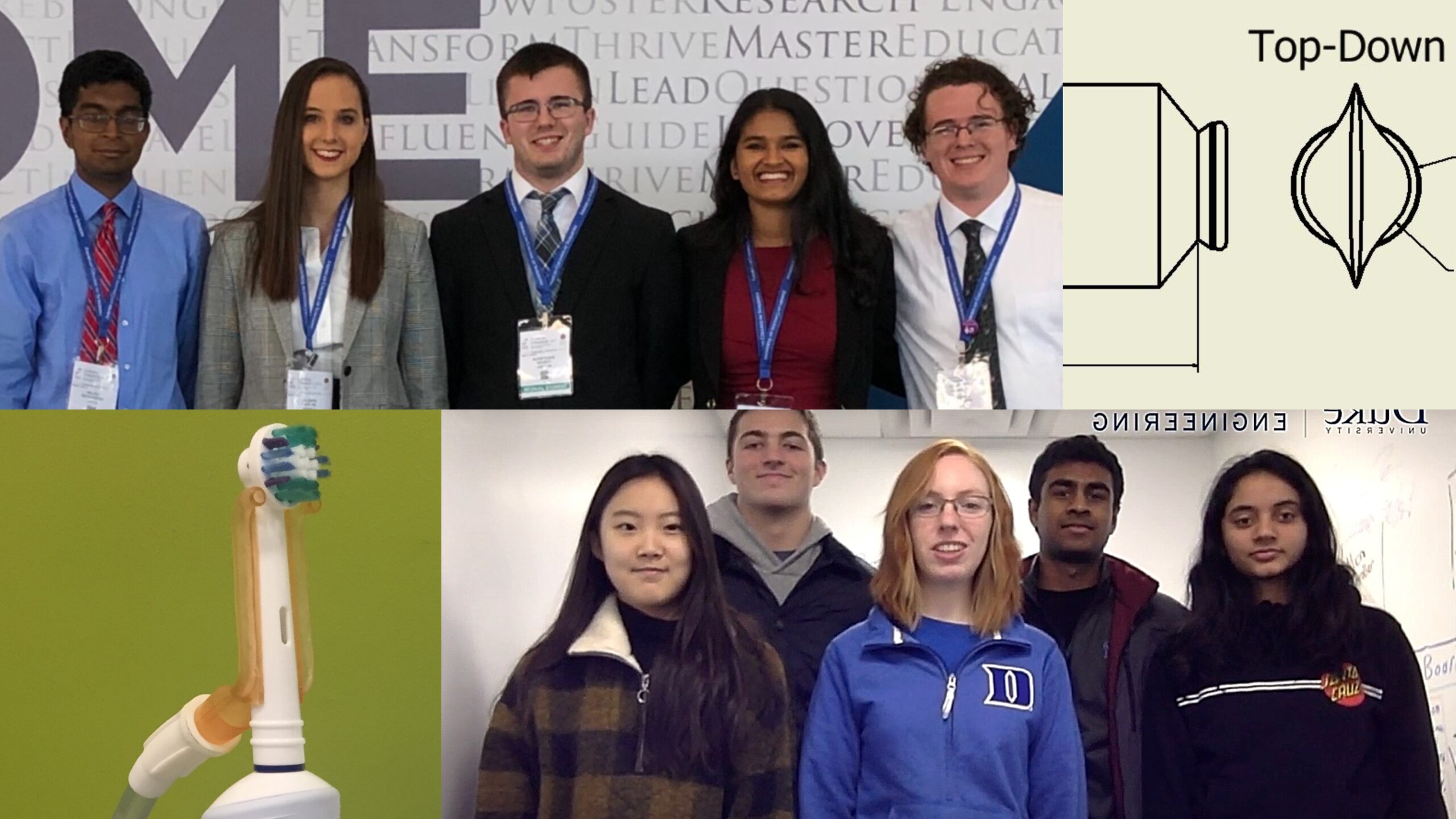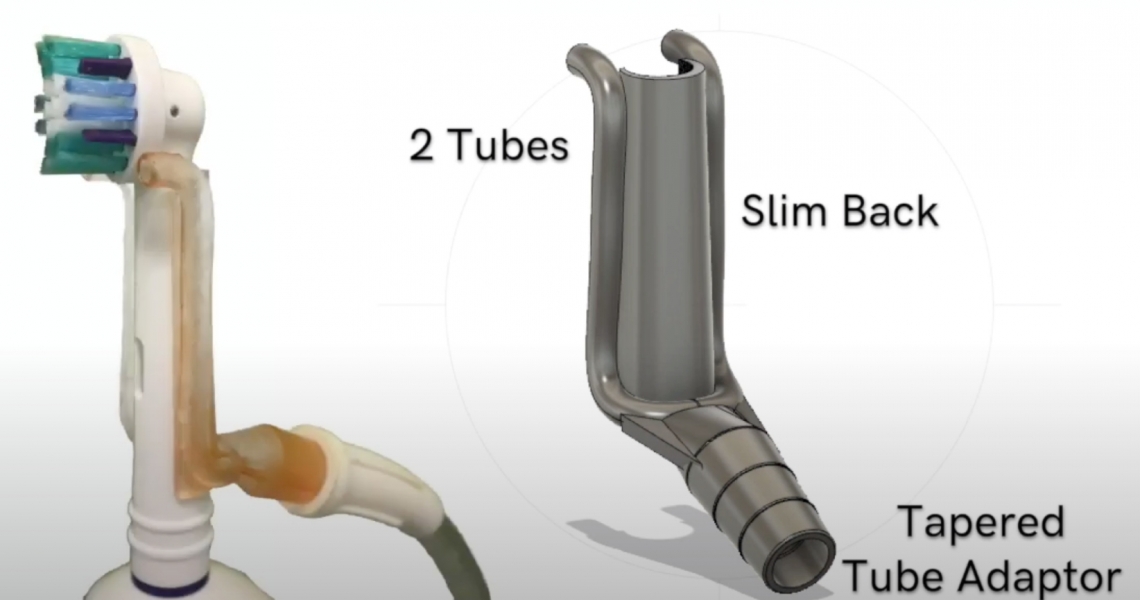Undergraduate Duke Engineering Design Teams Win National Prizes
Signature First-Year Design course inspires students to continue refining their projects, even years later

At Duke’s Pratt School of Engineering, first-year students are assigned real-life design challenges right from the start. And sometimes, they don’t want to stop designing even when the official assignment ends.
This year, two teams that have continued to refine and improve those projects will receive national honors in a National Institutes of Health-sponsored design competition.
Two Duke First-Year Design Program teams from fall 2018 that tenaciously and methodically kept working on their freshman-year design challenges in subsequent semesters will be recognized for their submissions to the NIH’s 9th annual Design by Biomedical Undergraduate Teams (DEBUT) challenge.
The Duke Engineering teams were recognized for their submissions to the NIH’s 9th annual Design by Biomedical Undergraduate Teams (DEBUT) challenge
A team of Duke Engineering undergraduates won third place overall–and a $10,000 prize–for their low-cost medical device to save the lives of infants born with gastroschisis, a severe congenital disability.
A second Duke team received honorable mention, and $1,000, for a design to improve the well-being of people with Amyotrophic Lateral Sclerosis (ALS) and other neurological conditions by making it easier to maintain oral hygiene.
The students took a course designed to follow-up on First-Year Design—EGR 102L: Design to Deliver, taught by Ann Saterbak, founder and director of the Duke Engineering First-Year Design Program.
“EGR 102 gives students the opportunity to continue working on design projects within a structured environment and with access to tools and materials needed for refining and testing prototypes,” said Ann Saterbak, who also created and teaches Design to Deliver. “When student teams continue to work on a project, there is real potential to deliver that product to the client, and/or develop the idea with an entrepreneurial mindset.”
DEBUT, considered the premier undergraduate design competition in biomedical engineering, received 86 applications from 46 universities in 20 states—engaging a total of 410 students. Winning designs were selected according to four criteria: the significance of the problem addressed, impact on clinical care; the innovation of the design; and a working prototype.
“The winners of this year’s DEBUT challenge show how students with a fresh perspective can develop innovative technologies that are low-cost and simple to use and yet can solve complex health challenges,” said Bruce Tromberg, director of the National Institute of Biomedical Imaging and Bioengineering (NIBIB), in a release announcing the winners. “It is exciting to see the next generation of biomedical engineers tackle these problems and how their unique skillsets and perspectives can make medical technology better, faster and less costly.”
The prizes will be awarded in an online ceremony at the annual Biomedical Engineering Society (BMES) conference on Oct. 15, 2020.
Gastroschisis Silo
The third-place winners designed a plastic bag with a semi-rigid opening, called a silo, to help save infants who suffer from gastroschisis, where the bowel develops outside the baby’s body.
The silo protects and contains the baby’s internal organs until they can be reintroduced into the abdomen. While children in high-income countries have a survival rate of more than 95 percent, babies in sub-Saharan Africa survive less than 10 percent of the time. Without a dedicated silo, clinicians may be forced to use an intravenous fluid bag or an examination glove.
 The Duke team’s device is an affordable alternative that costs less than $5 and could help dramatically increase children’s survival from gastroschisis.
The Duke team’s device is an affordable alternative that costs less than $5 and could help dramatically increase children’s survival from gastroschisis.
The project benefits from the robust relationship between Duke BME and the Duke University Medical Center. Tamara Fitzgerald, a Duke pediatric surgeon, is the team’s clinical faculty lead.
A Duke surgical resident and Master’s in Global Health student are assisting with animal studies. Duke Engineering’s relationship with Makerere University in Uganda has provided faculty, Julius Mugaga and Robert Sekitoleko, and local clinical specialists for consultation.
Team members Arushi Biswas and Caroline Salzman presented the project at the American College of Surgeons 2019 Clinical Congress. Other student team members students are Patrick Wilson, Nolan Burroughs and Muthukurisil Arivoli. All the students are members of the Duke Class of 2022. Saterbak is the faculty member of the team.
“We’re all excited and hopeful about taking this project forward,” she said. “Another exciting piece of news for our team is that our paper was accepted into the Journal of Surgical Research and will be published in print in November.”
The team, which received a $9,000 grant from the VentureWell BME-IDEA International Student Grants Program in May, hopes to travel to Uganda in 2021 to work with their Makerere biomedical engineering colleagues on testing and refining their design.
SipClip
The student team receiving honorable mention was initially presented with a problem by the Duke ALS Clinic. As ALS progresses, people develop bulbar dysfunction and dysphagia (a weakening of the muscles around the mouth and throat), making it difficult to swallow or spit.
Toothbrushing becomes difficult. Many people with late-stage ALS must use ineffective toothbrushing methods or not brush their teeth at all. Low-grade oral hygiene risks aspiration pneumonia and even death. The SipClip is a plastic device that makes brushing easier.

The SipClip team is students Ashley Myers, Meena Gudapati, Anish Karpurapu, Yoo Bin Shin, and Frank Marinello.
During their first year of working on the project, the team began initial trials at the Duke ALS Clinic. In 2019 and this year, the team moved into the customer discovery portion of the entrepreneurial path, interviewing doctors at Duke Health to learn about the prevalence of bulbar dysfunction.
Their project was accepted into TREAT, the Center for Translation of Rehabilitation Engineering Advances and Technology, in January. That relationship provided access to experts understanding the regulatory aspects of medical device creation.
The team was ready to start another round of testing in an assisted living home in Duke’s hometown of Durham when COVID-19 arrived. The team pivoted to potential licensee discovery and sought interviews with executives of large medical device companies.
“We are confident that our device, SipClip, can help many people not only with ALS, but other neurodegenerative diseases such as multiple sclerosis, Parkinson’s and cerebral palsy,” Myers said.
Team SipClip filed for a provisional patent in June.
They are working with Duke’s FastTrack medical device development program and plan to obtain approvals for eventual clinical testing. Their faculty mentors are Saterbak and Kevin Caves, an assistive technology designer at Duke Health and a Duke BME instructor.
Caves was honored in 2019 with Duke’s Betsy Alden Award for Outstanding Service-Learning, in recognition of his BME capstone senior design course on designing devices for people with disabilities He also teaches in the First-Year Design course.
More about
- First-Year Design Program »
- Signature Undergraduate Experience »
- Duke Engineering Entrepreneurship (EngEn) »
